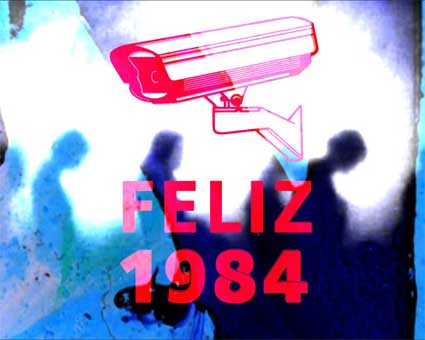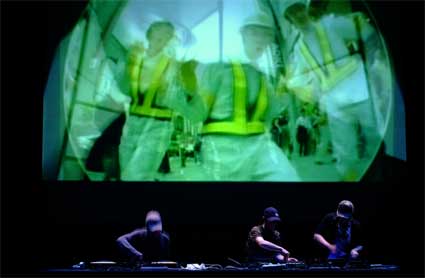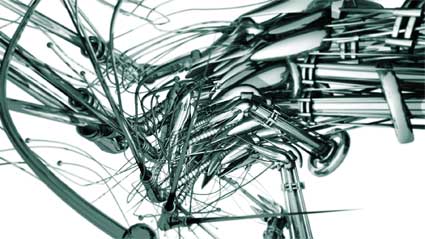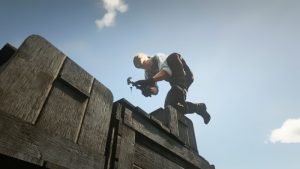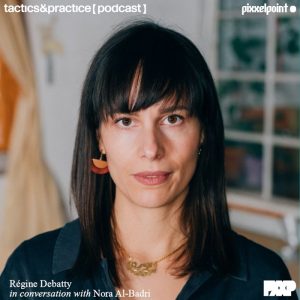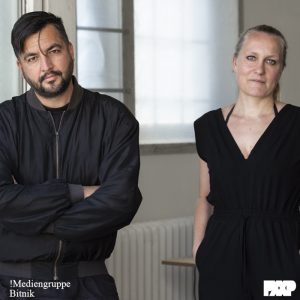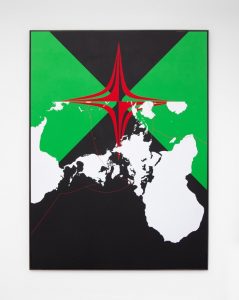ZEMOS98, a collective based in Seville (South of Spain), engages mainly in audiovisual activities which they regard as a tool for a possible education and re-education opposed to the one offered by the media and global culture.
 Since 1999, the collective organizes the zemos98 audiovisual festival. They are currently busy preparing the next edition of the festival which will take place on March 24-30, 2008. The international call for audiovisual video creations is out and the deadline to send your works is November 10.
Since 1999, the collective organizes the zemos98 audiovisual festival. They are currently busy preparing the next edition of the festival which will take place on March 24-30, 2008. The international call for audiovisual video creations is out and the deadline to send your works is November 10.
But ZEMOS98 cannot be reduced to a video festival, the group is also publishing essays, organizing exhibitions, producing and/or directing documentaries, etc. I’ve been following with a growing interest the activities of ZEMOS98 for a couple of years now and when Pedro Jiménez emailed me to inform me about one of their latest projects, i jumped on the opportunity and asked him if he’d find some time to answer my questions.
Pedro is involved in what looks like a thousand activities, online works, graphic design, educational projects, film production, activist projects, etc. He’s also an audiovisual artist and has participated to various exhibitions like borderhack 2.0 or big b[o]ther at the Walker Art Center. He co-directed documentaries such as Peatón Bonzo and is part of a group of documentary directors, cádiz.doc
Together with Chiu Longina, Pablo Sanz Almoguera, Juan Gil and José Antonio Sarmiento, Pedro writes on what is, imho, the best blog about sound art: mediateletipos. He also writes freelance for publications including >>forward, and gramagrass.org.
Other members of ZEMOS98 are Rubén Díaz, Felipe G. Gil, Juan Jiménez, Sofía Coca, Irene Hens, Cristina Domínguez, Benito Jiménez, Ricardo Barquín, Francisco González.
Pedro originally answered my questions in spanish, i translated them in english but if you’d rather read the interview in spanish, just click here and scroll down.
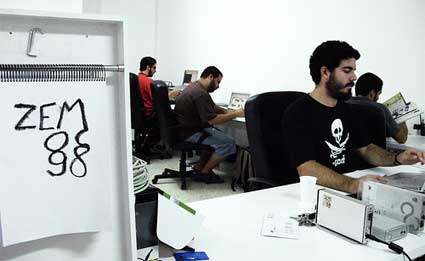 Photo by Benito Jiménez
Photo by Benito Jiménez
What is the story of ZEMOS98? And who is behind the collective?
ZEMOS98 was born as a group which produced videos. It started as something quite simple and humble, without any big ambition other than making short movies over the Summer. The first important moment was when some of us agreed on the idea to organize a festival where we could screen our own productions and start to show those from other film makers. The event kept growing and turned out to be our most important and well-known event: The ZEMOS98 Audiovisual Festival which will celebrate its 10th anniversary in March 2008.
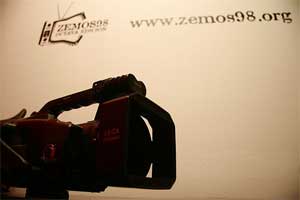
The group became bigger and bigger as our activities went bigger. From a voluntary and non-profit spirit, it became a way of earning our lives for some of us. From a small town, El Viso del Alcor, with 15 000 inhabitants, 30 km from Seville and far away from its metropolitan area we have finally settled in Seville, the capital of Andalusia.
Today we are still a group involved in audiovisual productions but most of all we are interested in thinking about exhibition formats for what we call the “audiovisual culture”. It cannot be reduced exclusively to video art, to short movies with cinematographic undertones, or to audiovisual shows. Instead it draws together in the different formats i’ve just mentioned and it is further enhanced by our interest in music and other artistic practices (theatre, performance, literature, etc.), the reflexion, the edition of books and our own website which is a publication/blog dealing with contemporary audiovisual culture.
We have always regarded internet more as a living space, but we’ve never said that we make culture for internet. Instead we have used the technology as a tool and it is clear that the technology that can be located online is the one that we’ve used the most.
This theoretical and practical background has allowed us to create a company which produces and sustains economically the Festival Audiovisual ZEMOS98 and our own productions. This company has also allowed us to turn our vision of culture into a professional activity.
It enables us to work on other projects for other clients, as it happened for the exhibition Repeat Please: Cultura VJ (main page) which was commissioned by the Instituto Andaluz de la Juventud (Youth Institute of Andalusia).
All of the above has enabled ZEMOS98 to survive, if we had kept our efforts on a pure voluntary and non-lucrative level we would probably have had to dedicate our energy somewhere else.
Nowadays we are 7 people working all year long on our activities and during the festival, our number doubles as we invite other people to join us and work on the production and curating tasks. But as years pass some collaborators come and go and for some reason or another they are now involved in other kind of activities.
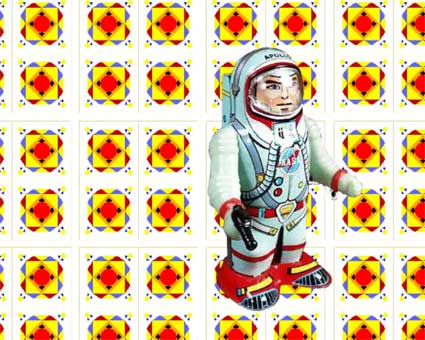 ZEMOS98 was born in 1995. Have your objective and role changed since 1995?
ZEMOS98 was born in 1995. Have your objective and role changed since 1995?
ZEMOS98 keeps on re-inventing itself bit by bit. We strongly believe that one of our best asset is the constant self critique. Back in 1995 our main objective was to finish a short movie about mutant zombies. Nowadays the projects are much wider and more ambitious.
Let’s say that in terms of content and scale of vision we have changed. We’ve learned so much since 1995 as we have associated our education -ever since we were at school and even more when we were studying in the university- with our own artistic practice.
Most of us have studied disciplines related to audiovisual communication and image, we have also gained much knowledge in post grads and by becoming autodidacts in computing, technology and education.
Despite all that, there are things which have not changed such as the way we regard culture as a medium for social action. Cultural processes are educative processes, for us who are the first involved but also for the public in general who visits the festival and reads our publications.
This union between education and communication has been part of our philosophy for a long time. And deep down, we know that such vision of culture implies a political vision, that’s why we have never hesitated to take part in social movements such as the foundation of Indymedia Estrecho or the one of the Plataforma de Reflexión de Políticas Culturales (Platform for Reflexion on Cultural Politics) which protests against the Contemporary Art Biennale of Seville (BIACS).
How about the way your work is perceived and recognized? Do you find it easier to get what you want today or does each year bring new challenges?
We are a very multidisciplinary group and the perception that people have of ZEMOS98 is that we kind of have a finger in every pie. That’s not exactly the case, but what is true is that we have extended our scope and in turn it has expanded thanks to the network.
We are probably more involved in particular fields than in others but that flexibility sometimes allows us to become some sort of bridge between proposals which would otherwise have very little point of contact with each other.
We have taken great care of the communication of the ZEMOS98 “brand” and the media support, both local and national, is quite important. This key, the one of the media, is fundamental if one wants to obtain public fundings.
Politicians do not really know how to identify where and who are the key actors of the cultural production but what they do know is that if the press is talking about one of them, then it might be worth their attention. It is a sad situation but we cannot complain either as we know how to play that game.
In any case, during the last edition of ZEMOS98, we had to face issues of space for some of the musical activities as some people just couldn’t get in and we are quite worried about that. However, not all our activities meet with an immediate success in terms of attendance but we are not obsessed with numbers anyway.
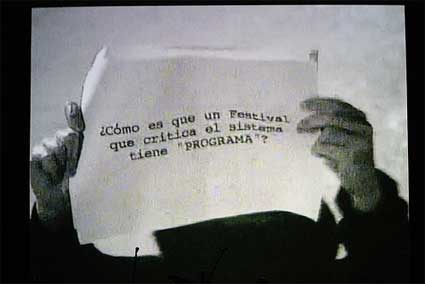 ZEMOS98 9th edition, picture by Antonio Iglesias
ZEMOS98 9th edition, picture by Antonio Iglesias
ZEMOS98 has recently decided to remunerate the authors that take part in the official section of its audiovisual festival. Why do you think that festival organizers and sponsors take it for granted that the authors do not need to be remunerated? Why is it still so difficult to recognize that artists have the right to be paid for their work?
As far as we are concerned, the decision was quite simple. No one questions the fact that musicians performing in a festival should get paid. The same goes for the company which prints the promotional posters of the festival. Why shouldn’t the audiovisual works, which are part of your programme, get some remuneration?
One often assumes that the fact that they enter a competition to get an award is enough. But we have never believed in awards and now that we can afford to pay them we have decided that the best way to contribute to the creation of new art works is to remunerate their authors.
That’s something which ought to be taken for granted and we are doing our best to convince other festivals to do the same, there should be a general remuneration even for works which might never receive the first prize but nevertheless deserve to be part of the official programme.
We know that there are other festivals that do the same but we are also aware that some museums do not even regard it as an issue. They usually have this idea that as a newcomer, you should be grateful to be allowed to present your work in their venue.
The other point is that we think that remuneration for an exhibition increases the value of what we are screening. Besides, we are taking our cue from a legal void as we are paying for a right that usually only collective entities such as SGAE (General Society of Authors and Publishers of Spain) get paid for. The good thing is that everyday less artists subscribe to these entities and this in turn allows us to pay directly the people who created the video, without intermediaries.
The point is not whether we believe or not in laws or copyright but we think that if we distribute money this way and if other join the initiative, a whole circuit of works of major quality might emerge. Or at least one could see the dawn of a different way to generate profit for a short movie.
Apart from the now famous audiovisual festival, what are the other activities of ZEMOS98?
We’ve already listed a few.
But beyond the festivals, we always end up doing projects that emerge from the festivals, such as the exhibitions but also the publications. We have released 5 DVDs presenting the highlights of the festival, one each year starting on the 5th edition of the festival. Until today we have published two books which have had an important impact.
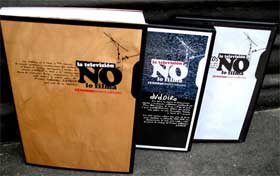 The first one Creación e Inteligencia Colectiva (Creation and Collective Intelligence) is our “best-seller” because it’s the one that people have downloaded the most. It’s a collective book which gathers together what happened during the 7th edition dedicated to the collective intelligence, but what makes it interesting is the fact that it expands the scope of the festival through the very pertinent contribution of the most relevant experts of this field in Spain. The book is still a valuable reference today for anyone willing to understand the creative, legal and social dimension of the phenomenon, way beyond the copyright issue and the current system of author’s rights.
The first one Creación e Inteligencia Colectiva (Creation and Collective Intelligence) is our “best-seller” because it’s the one that people have downloaded the most. It’s a collective book which gathers together what happened during the 7th edition dedicated to the collective intelligence, but what makes it interesting is the fact that it expands the scope of the festival through the very pertinent contribution of the most relevant experts of this field in Spain. The book is still a valuable reference today for anyone willing to understand the creative, legal and social dimension of the phenomenon, way beyond the copyright issue and the current system of author’s rights.
Last year we released a collective pack titled La Televisión No Lo Filma (Television does not film that) which gathers some thoughts and essays on the possibilities offered by the tv medium. The pack also contains a DVD we have created to propose alternatives to television.
The books are available for download in PDF format both in spanish and english.
Now we are working on a book dedicated to the 9th edition of ZEMOS98 and to the exhibition co-commissioned by the Fundación Rodríguez: Panel De Control.
We are also spending some time traveling and giving talks on some of the topics that we publish. We actually enjoy doing that as it allows us to get to know better other festivals, other projects and the cities where we are invited. We have recently published a book in PDF format about Digital Culture and Participatory Communication (download the PDF).
Our latest audiovisual work is a long-motion documentary, made in collaboration with ZAP Producciones. It gives a very peculiar vision of the important role played by football in the integration of immigrants. Football is the most important sport in this country and it has actually provided us with a very interesting perspective to explore the theme of immigration. More information on this website (english presentation of La Liga de Los Olvidados).
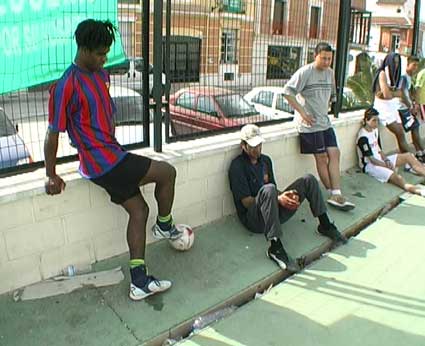 Screenshot from La Liga de Los Olvidados
Screenshot from La Liga de Los Olvidados
Some of the audiovisual art works of ZEMOS98 are distributed on an international level through the project HAMACA, a new distributor of Spanish video art.
Then on a more personal level, Pedro Jiménez distributes his videos through this webpage and some of us presents their own projects (whether they are personal or not) on the blogs which have been recently created on our website.
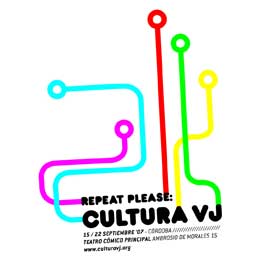 You are organizing the exhibition Repeat Please: Cultura VJ for Eutopia 07, the II European Festival of Young Creation. The press release reads: “VJ has established itself as a discipline like any other within the contemporary art and performance scene?”
You are organizing the exhibition Repeat Please: Cultura VJ for Eutopia 07, the II European Festival of Young Creation. The press release reads: “VJ has established itself as a discipline like any other within the contemporary art and performance scene?”
How did VJ become acclaimed artists? What are the reasons why we should regard VJs as artists? What are the main characteristics of their discipline?
Truth is that one of the aims of this exhibition was precisely to demonstrate that VJs are artists. Our vision of art is fairly wide but more importantly we have no intention to propose a vision which would be elitist or supracultural, Marcel Duchamp said that a long time ago and we trust him. Anyone can become an artist.
On the other hand, we have to face a professional reality where VJs are usually treated as interior designers of night clubs, in a strictly technical sense. However, we believe that most VJs are more related to DJs, in other words, to electronic music artists.
We all know that there are many DJs and very probably many among them are bad DJs, bad in the sense that their sessions bring very little sensations and their work doesn’t go beyond the mere addition of songs and melodies one after the other. Something similar happens with the VJ although there are differences on various levels.
There are indeed some night club VJs which have probably much more in common with a light technician than with an artist. Many VJs are hired by the companies which provide the technical support.
But the artists we find interesting are those who have decided to get out of the club life or who go further and work with video installations or the ones who are involved in the research and programming of software-art.
The starting point of this project was to explore ideas of re-appropriation and sampling and as we were investigating the topic we realized that sampling is not one of the characteristics which best defines a VJ.
Most VJ snob the reused material and they often treat it as just support material. However, there are other artists –maybe the best ones? who regard sampling for what it is: a form that allows them to re-interpret the reality in which we live.
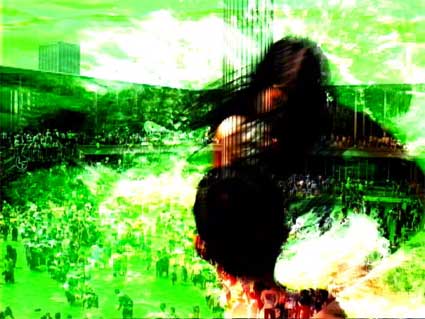 Fountain (v.3) by Benton-C
Fountain (v.3) by Benton-C
We never get tired of thinking that we are living inside images, so taking something from a movie, from tv or from youtube is nothing else than an act of reflexion on our own culture. But not everyone would agree on that point.
The characteristics that all the VJs have in common is that they have a clear interest in working live. There’s a big component of performance in VJing as everyone thinks that one can really see your work in a live context, that’s why we’ve been calling VJing for some time “the art of live video”.
Whether it is art or not, it is nevertheless a contemporary cultural practice which deserves our attention, not only because of all the technological work which can be developed (sensors, multiscreens, etc.), but also because in a sense, VJing proposes a space time dimension which is different from the usual audiovisual narration. And that is something we’ve always found interesting.
The exhibition proposes to introduce and inform about VJing and we hope it will trigger some reflexion about the theme of the VJ as an artist.
How active and creative is the Spanish VJ scene? Could you tell us a few words about it?
The most interesting element that we’d like to highlight as far as Spain is concerned is the idea that not everything is produced inside the usual places that produce contemporary culture: Madrid and Barcelona. Instead, there are many places in the country, on the periphery, where we are located as well, where this kind of culture thrives.
Another characteristic is that the Spanish cultural scene is emerging. Although i do not think that it is very big, one can see the creation of initiatives such as the vjspain.com community which gathers people involved in VJ culture and enables them to get to know each other and work collectively.
Although there are many musical festivals in Spain and their number keeps growing by the day, it is strange to observe that even very important festivals like Sónar do not reserve an important place to VJs in their programme. This section of the Barcelona-based festival is quite superficial and generally speaking events related to the world of VJing are organized but, at the exception of the ZEMOS98 programme, they are only one or two years old at most. Nevertheless there have been some peculiar cases which turned out to be really interesting. LUX06 is one of them. Many important VJs from all over the world got to meet each other in Seville for this international meeting.
The movement is just taking off. Quite a few workshops are organized these days and an important VJ recently told us that now is the time to provide as much information as possible because the accessibility has this effect that anyone can become a VJ today using demo loops and presets.
Hence the importance of information, so that those who organize and curate festivals can get a better view of what is going on and who is who in the VJ world. We are trying to bring this vision, our vision, on the phenomenon and while preparing the exhibition, we have dedicated much efforts to showing what is happening now in Spain.
For the 8th edition of ZEMOS98 a couple of years ago you also set up Reclaim the Spectrum, an exhibition of artworks which engage with the electromagnetic space. How did an exhibition about something which is usually silent and invisible end up being part of an audiovisual exhibition?

It was an idea of the curator, José Luis de Vicente. We were looking for contents for this 8th edition of the festival dedicated to the possibilities offered by tv. We called it “Más allá de la televisión” / “Beyond Television” and we realized that José Luis’ project would be perfect fit for the festival. And without hesitation we started to work on it.
The exhibition was actually very audiovisual because the works that make the radio spectrum visible precisely allow the visitor to watch and listen. We’ve always been interested in that theme and José Luis de Vicente‘s work for the exhibition and the conference helped us understand the topic much better. In fact the idea that “the radio spectrum is the real estate of the information society” is now engraved in our point of view on the subject.
Besides, in our daily activities, whether we are talking about intellectual property, cultural activism or society of control analysis, we keep on encountering many aspects similar to those discussed in Reclaim The Spectrum. The works which have been exhibited during the 8th edition of the festival could have been proposed in Panel de Control.
You are established in Seville. Could you name us a few contemporary artists from or based in Seville who should get more attention from the public (and why)?
We can mention three examples which are close to our interests and are part of the ZEMOS98 context although they are different from each other.
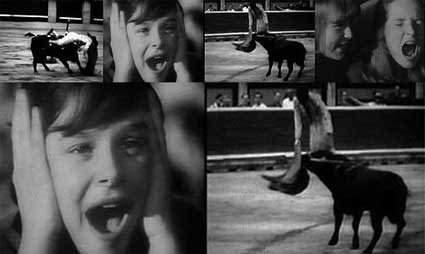 La Cosa Nuestra
La Cosa Nuestra
There is María Cañas, a videoartist and archivist who collects in an almost maniacal way images related to the most typical myths of our culture. She has recently worked on the topic of Sevillan baroque style and its relationship with pornography. In the video La Cosa Nuestra which received a production support from ZEMOS98 she explores the figure of the bull. Before that she worked on the pig and organized a competition which offered as a first prize a jamón de bellota*. Each of María’s pieces is an authentic audiovisual essay.
A very important group, with whom we have worked as well, is Hackitectura.net. They are involved in various projects of media and social activism but from an architectural point of view.
Hackitectura.net work on the cyborg dimension of the media-architecture and the social processes. They are currently supporting the creation of a wiki-plaza in Seville. They participate to the development of a very interesting and powerful global streaming platform called Giss.tv and they have recently organized several days dedicated to Media-Architecture.
We should also highlight the work of José Luis Tirado, his work might be less well-known than the one of other artists but he is curiously the most mature when it comes to teaming up audiovisual and activism. His reflexions on concepts of frontier, on the Strait of Gibraltar and immigration in general is quite meaningful. It is with him that we have realized La Liga de los Olvidados which we mentioned earlier and his long feature films are as interesting as the short one.
In Seville there are also exciting cultural initiatives in many fields, the musical one is interesting at many levels, from the
Hip-Hop of Tote King to the drone metal of Orthodox or Sr Chinarro and his Duchamp-esque pop. There are other figures, important albeit not famous. Maybe because we’ve worked with him we have to mention Pedro G Romero, especially his work with flamenco dancer Israel Galván and of course there are stars such as Federico Guzmán or the architect Santiago Cirugeda…
We actively stay in touch with most of them and through PRPC (Platform for Reflexion on Cultural Politics) we work with the city. This is a collective platform created two years ago to fight against the Biennial of Contemporary Art of Seville BIACS.
Promo Festival Audiovisual zemos98
Uploaded by zemos98
Any upcoming project you could share with us?
Apart from Cultura VJ and the Panel de Control book, we have a few other activities to keep us busy until the end of the year.
The most important one is the international tour of the DVD of the 9th edition of ZEMOS98, we are looking for art and cultural centers which might be interested in screening it.
We are also thinking of having traveling exhibitions, the Cultura VJ and the Panel de Control ones in particular. Besides, we are working on other projects for other cities. For example, the programming of a series of experimental music events called Experiencias Sonoras.
But we are now working hard on the next edition of ZEMOS98 which will take place on March 24 to 30, 2008. The international call for participation for short videos is out. The deadline to send the works is November 10.
What we can reveal you is that we are working together with Mar Villaespesa, a curator and friend, on a special edition of ZEMOS98 which is about to celebrate its 10th anniversary.
Muchas gracias Pedro!
* First-class ham made from pigs which have only been fed only acorns (bellota)
Related stories: Book review: Audio-Visual Art and VJ Culture, VScratch, Remote Vjs control, Sewing machine VJ, PostVinyl, Tremor tactile music sleeve, Interview of UnitedVisualArtists.

